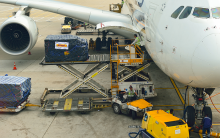 According to a latest report by Trade And Transport Group titled, India Air Cargo Outlook 2023, “The Indian air cargo market generated 2.2 million tonnes of traffic-1/5th the size of China’s and about 1/10th the size of the U.S. air cargo market – with about 30 per cent of the traffic generated on the domestic and the remainder on the international sectors. “Around 90 per cent of international traffic is carried by non-Indian carriers with Gulf-based carriers as well as Aerologic (operating for Lufthansa Cargo and DHL), Cathay and Turkish being the most important.” Cargo handled across Indian airports may touch 2.4-2.5 million tonnes in 2023 even as passenger/belly capacity comes back, says Frederic Horst, Managing Director, Trade and Transport Group.
According to a latest report by Trade And Transport Group titled, India Air Cargo Outlook 2023, “The Indian air cargo market generated 2.2 million tonnes of traffic-1/5th the size of China’s and about 1/10th the size of the U.S. air cargo market – with about 30 per cent of the traffic generated on the domestic and the remainder on the international sectors. “Around 90 per cent of international traffic is carried by non-Indian carriers with Gulf-based carriers as well as Aerologic (operating for Lufthansa Cargo and DHL), Cathay and Turkish being the most important.” Cargo handled across Indian airports may touch 2.4-2.5 million tonnes in 2023 even as passenger/belly capacity comes back, says Frederic Horst, Managing Director, Trade and Transport Group.
“With 5-6 Indian conglomerates investing abroad, the India link is always going to be strong. So, India is in a good position as far as trade is concerned.” International cargo traffic has not yet recovered to pre-pandemic levels but domestic traffic has, driven by express, e-commerce as well as general freight traffic, the report said. Five Indian carriers now operate freighters. “Three of these – IndiGo, Quikjet and Pradhaan Air Express – commenced operations in the last 12 months using narrow body freighters.” Five carriers are in various stages of start-up “but the Indian air cargo landscape is littered with just as many failed airlines.”
The largest carrier in the Indian market is currently Aerologic (14 percent) followed by Qatar Airways (12 percent), Emirates (12 percent), Air India/Air India Express (8 percent) and Cathay Pacific (7 percent). Turkish Airlines has increased its share to about 5 percent of the market. (In the case of Aerologic, there has been a degree of substitution between traffic carried by Lufthansa Group airlines and Aerologic. Aerologic is a 50:50 joint venture between DHL and Lufthansa with Lufthansa marketing five out of 21 aircraft operated by the carrier.) “Air India and Air India Express account for 2/3rd of traffic carried by Indian carriers with IndiGo, Vistara and SpiceJet accounting for the balance.” Economic rationale for growth “With economic and trade growth expected to outperform in the near term, there are opportunities for growth – driven by imports and exports of intermediate and manufactured goods as well as e-commerce traffic. India could also benefit from a U.S. and European pivot away from China but that depends on how manufacturing capacity develops, particularly across consumer goods and high tech sectors.” India’s trade in manufactured goods is higher than prior to the pandemic, and exports increased by almost 10 percent and imports by 17 percent in 2022. “We expect exports in a number of sectors including industrial equipment and parts, automotive, pharmaceuticals and some high tech sectors to do well. Apparel and footwear and household goods less so. “On the import side, we expect industrial equipment and parts, semiconductors and equipment and automotive sectors to grow.”
Breaking News
- ‘Customs House Agent–Air’ award goes to Tulsidas Khimji @ICA 2025
- CargoAi, Qatar Cargo unite to simplify global bookings
- Raipur–Vizag corridor cuts gap by 130 km, boosts road freight
- Delhivery ferries medicines via VTOL drone in Deoria, UP
- ‘Agents may succeed in promoting their products export such as processed minerals, pharmaceuticals, chemicals, tea, steel to Russia’
- ‘The corridor will reduces transportation time & costs, boost Indian exports’
- ‘The corridor will open new gateways for commodities & multimodal logistics’
- ‘Persistent trust deficit, unresolved border issues between India, China must be resolved’
- ‘Agents will benefit with lanes, higher volumes, more capacity‘
- ‘The corridor will strengthen supply chain resilience & open new trade lanes’
- GOX grabs Emerging Terminal Operator Award at ICA 2025
 Cargo Breaking News
Cargo Breaking News


